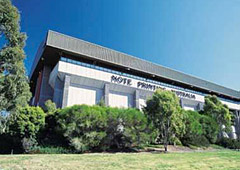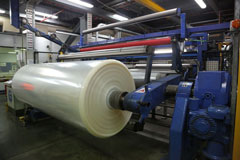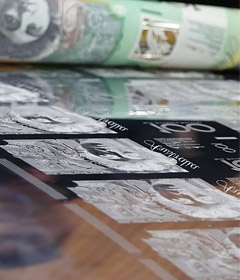New banknotes: Design & production Video Transcript
We started the research and development process for the upgrade with an extensive list of nearly 200 features that we'd gathered from all sources around the world: industry, research institutes, suppliers to the industry and started with that and then cut it back. We can't put 200 features on the note, we don't want to, so we cut it back to a very short list that we took forward into design.
In the design process we have two distinct parts, there's the concept design and the 'banknotisation' design. The concept design is where we look at the artwork, how we want it to look more general aspects; the 'banknotisation' design is where we actually integrate all the features into that and get the banknote to a level where its functional, has security and durability.
So the process starts with a plastic film, which is essentially some polypropylene that we melt, stretch, blow into a big bubble and then squash it back down to get a film. So on top of that clear film we apply white coatings on both sides, obviously leaving out the bits where we want to have a window and that produces for us a banknote substrate sheet we can then put into the rest of the printing processes.
So on top of that, the white layers on the banknote sheet, we apply strong colours on both sides of the note, and this is done in very fine detailed print. It gives it the bold, vivid colours, it has built in security in terms of the fine detail and microprint that goes within that.
Within the top-to-bottom window, which is new on the series for us, we integrate a number of features in there, particularly stuff that goes in the foil that's transferred across. It's a very complicated process that involves transferring that foil across with heat and pressure, somewhat akin to ironing it on, and that transfers those across to the banknote and you have them in the top-to-bottom window.
The next process we apply is the rolling colour effect. Again, this done partly across the window and across some of the coloured areas where we apply a thick layer of a coloured ink. And then we structure the way the pigments sit within that ink to get the coloured effects that you see on both sides of the note.
The way we structure the pigments within that rolling colour effect to give the artwork is that we apply a series of magnets on to the ink while it's still wet and that magnetic fields rotate the pigments within the ink and then we lock it in place with the UV lamp to cure that, and then we get the rolling colour effect in the design that we're after.
The intaglio print comes after that, which is a very traditional process used for many, many years all around the world in banknotes. Applied on both sides of the note, it gives the note texture, gives the note body, something that really helps with the way people authenticate the note. They will often feel the difference between the note with or without intaglio.
On the new five dollar banknote, space was really a constraint. We were after a lot of security and one of the things that had to go was the second serial number. So we've still got one, consistent with the same sort of numbering formats we've used in the past so you can see the year of print that comes out of that, and we've also matched that against an invisible year of print which you can see when you hold the note under a UV lamp.
One of the last printing processes is to apply an overcoat over the whole note. This adds both durability and it helps with the slip characteristics of the note. So how it feels when you're counting it, the way the notes can slide against each other.
One of the final processes then is the tactile feature, the tactile dot, where we're not printing anything in this case. We're just actually hitting the film with an embossing stamp, it actually deforms it and pushes it out and you get the tactile dot that you then can feel on the note for the vision impaired.
So in finishing, we take everything up to this stage and have banknote sheets. Then we have to cut it into the individual banknotes and making sure that's done consistently so you get the right height, the right length, the image in the right position and then it's put through a high speed machine inspection system that does quality checking on all the banknotes.
Once the notes have been through processing they get bundled into you know bundles of a hundred and bigger bundles of a thousand and they all get packed into containers with a sort of automated robotic system so then those containers have some 100,000 notes that get sent out to banks.
To replace all the notes in circulation we've needed to print around 170 million of the five dollar banknote. Normally we'd not print that many in each year but it's the volume that we need to replace everything.
Coming to the end of the process, we've got to the stage now where we've incorporated a large number of new security features, some of the most advanced in the world, on to this new design. And you know where once we led the world in polymer banknotes, our view is certainly, this new design with the embedded features and the way we've designed it together, certainly puts us back at the forefront of polymer note technology in the world.






